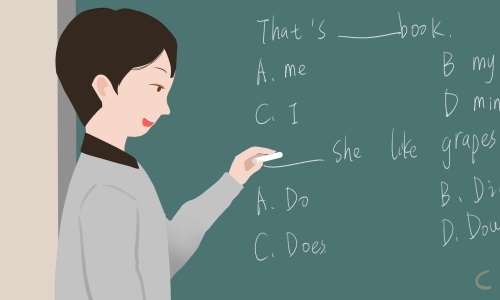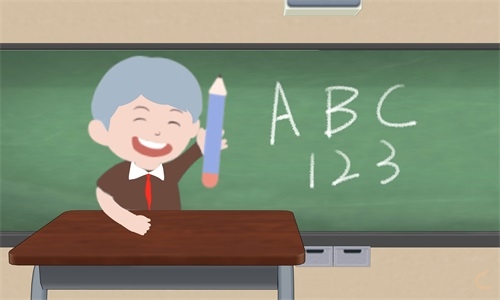初二英语语法
语法是英语考试中的重中之重,所占分值也多。提高英语能力的方法是多读多练多积累。小编在这里整理了初二英语语法供大家阅读,希望能帮助到您。
初二英语语法
1) leave的用法
1.“leave+地点”表示“离开某地”。例如:
When did you leave Shanghai?
你什么时候离开上海的?
2.“leave for+地点”表示“动身去某地”。例如:
Next Friday, Alice is leaving for London.
下周五,爱丽斯要去伦敦了。
3.“leave+地点+for+地点”表示“离开某地去某地”。例如:
Why are you leaving Shanghai for Beijing?
你为什么要离开上海去北京?
2) 情态动词should“应该”学会使用
should作为情态动词用,常常表示意外、惊奇、不能理解等,有“竟会”的意思,例如:
How should I know? 我怎么知道?
Why should you be so late today? 你今天为什么来得这么晚?
should有时表示应当做或发生的事,例如:
We should help each other.我们应当互相帮助。
我们在使用时要注意以下几点:
1. 用于表示“应该”或“不应该”的概念。此时常指长辈教导或责备晚辈。例如:
You should be here with clean hands. 你应该把手洗干净了再来。
2. 用于提出意见劝导别人。例如:
You should go to the doctor if you feel ill. 如果你感觉不舒服,你最好去看医生。
3. 用于表示可能性。should的这一用法是考试中常常出现的考点之一。例如:
We should arrive by supper time. 我们在晚饭前就能到了。
She should be here any moment. 她随时都可能来。
3) What...? 与 Which...?
1. what 与 which 都是疑问代词,都可以指人或事物,但是what仅用来询问职业。如:
What is your father? 你父亲是干什么的? 该句相当于:
What does your father do?
What is your father's job?
Which 指代的是特定范围内的某一个人。如:
---Which is Peter? 哪个是皮特?
---The boy behind Mary. 玛丽背后的那个男孩。
2. What...?是泛指,所指的事物没有范围的限制;而 Which...?是特指,所指的事物有范围的限制。如:
What color do you like best? (所有颜色)
你最喜爱什么颜色?
Which color do you like best, blue, green or yellow? (有特定的范围)
你最喜爱哪一种颜色?
3. what 与 which 后都可以接单、复数名词和不可数名词。如:
Which pictures are from China?
哪些图片来自中国?
4) 频度副词的位置
1.常见的频度副词有以下这些:
always(总是,一直)
usually(通常)
often(常常,经常)
sometimes(有时候)
never(从不)
2.频度副词的位置:
a.放在连系动词、助动词或情态动词后面。如:
David is often arrives late for school.
大卫上学经常迟到。
b.放在行为动词前。如:
We usually go to school at 7:10 every day.
我们每天经常在7:10去上学。
c.有些频度副词可放在句首或句尾,用来表示强调。如:
Sometimes I walk home, sometime I rides a bike.
有时我步行回家,有时我骑自行车。
3.never放在句首时,主语、谓语动词要倒装。如:
Never have I been there.
5) every day 与 everyday
1. every day 作状语,译为“每一天”。如:
We go to school at 7:10 every day.
我们每天7:10去上学。
I decide to read English every day.
我决定每天读英语。
2. everyday 作定语,译为“日常的”。
She watches everyday English on TV after dinner.
她晚饭后在电视上看日常英语。
What's your everyday activity?
你的日常活动是什么?
6) 什么是助动词
1.协助主要动词构成谓语动词词组的词叫助动词(Auxiliary Verb)。被协助的动词称作主要动词(Main Verb)。
助动词自身没有词义,不可单独使用,例如:
He doesn't like English. 他不喜欢英语。
(doesn't是助动词,无词义;like是主要动词,有词义)
2.助动词协助主要动词完成以下功用,可以用来:
a. 表示时态,例如:
He is singing. 他在唱歌。
He has got married. 他已结婚。
b. 表示语态,例如:
He was sent to England. 他被派往英国。
c. 构成疑问句,例如:
Do you like college life? 你喜欢大学生活吗?
Did you study English before you came here?你来这儿之前学过英语吗?
d. 与否定副词not合用,构成否定句,例如:
I don't like him. 我不喜欢他。
e. 加强语气,例如:
Do come to the party tomorrow evening. 明天晚上一定来参加晚会。
He did know that. 他的确知道那件事。
3. 最常用的助动词有:be, have, do, shall, will, should, would
7) forget doing/to do与remember doing/to do
1.forget to do 忘记要去做某事。 (未做)
forget doing 忘记做过某事。 (已做)
The light in the office is still on. He forgot to turn it off.
办公室的灯还在亮着,它忘记关了。(没有做关灯的动作)
He forgot turning the light off.
他忘记他已经关了灯了。 ( 已做过关灯的动作)
Don't forget to come tomorrow.
别忘了明天来。 (to come动作未做)
典型例题---- The light in the office is still on. ---- Oh,I forgot___.
A. turning it off B. turn it off
C. to turn it off D. having turned it off
答案:C。由the light is still on 可知灯亮着,即关灯的动作没有发生,因此用forget to do sth.而forget doing sth 表示灯已经关上了,而自己忘记了这一事实。此处不符合题意。
2.remember to do 记得去做某事 (未做)
remember doing 记得做过某事 (已做)
Remember to go to the post office after school.
记着放学后去趟邮局。
Don't you remember seeing the man before?
你不记得以前见过那个人吗?
8) It's for sb.和 It's of sb.
1.for sb. 常用于表示事物的特征特点,表示客观形式的形容词,如easy, hard, difficult, interesting, impossible等:
It's very hard for him to study two languages. 对他来说学两门外语是很难的。
2.of sb 的句型一般用表示人物的性格,品德,表示主观感情或态度的形容词,如good, kind, nice, clever, foolish, right。
It's very nice of you to help me. 你来帮助我,你真是太好了。
3.for 与of 的辨别方法:
用介词后面的代词作主语,用介词前边的形容词作表语,造个句子。如果道理上通顺用of,不通则用for。如:
You are nice. (通顺,所以应用of)。
He is hard. (人是困难的,不通,因此应用for。)
9) 对两个句子的提问
新目标英语在命题中有将对句子划线提问这一题型取消的趋势,现在采取的作法是对一个句子进行自由提问。例如:
句子:The boy in blue has three pens.
提问:1.Who has three pens?
2.Which boy has three pens?
3.What does the boy in blue have?
4.How many pens does the boy in blue have?
很显然,学生多了更多的回答角度,也体现了考试的灵活性。再如:
句子:He usually goes to the park with his friends at 8:00 on Sunday.
提问:1.Who usually goes to the park with his friends at 8:00 on Sunday?
2.Where does he usually go with his friends at 8:00 on Sunday?
3.What does he usually do with his friends at 8:00 on Sunday?
4.With whom does he usually go to the park at 8:00 on Sunday?
5.What time does he usually go to the park with his friends on Sunday?
6.When does he usually go to the park with his friends?
10) so、such与不定冠词的使用
1.so与不定冠词a、an连用,结构为“so+形容词+a/an+名词”。如:
He is so funny a boy.
Jim has so big a house.
2.such与不定冠词a、an连用,结构为“such+a/an+形容词+名词”。如:
It is such a nice day.
That was such an interesting story.
11) 使用-ing分词的几种情况
1.在进行时态中。如:
He is watching TV in the room.
They were dancing at nine o'clock last night.
2.在there be结构中。如:
There is a boy swimming in the river.
3.在have fun/problems结构中。如:
We have fun learning English this term.
They had problems getting to the top of the mountain.
4.在介词后面。如:
Thanks for helping me.
Are you good at playing basketball.
5.在以下结构中:
enjoy doing sth 乐于做某事
finish doing sth 完成做某事
feel like doing sth 想要做某事
stop doing sth 停止做某事
forget doing sth 忘记做过某事
go on doing sth 继续做某事
remember doing sth 记得做过某事
like doing sth 喜欢做某事
keep sb doing sth 使某人一直做某事
find sb doing sth 发现某人做某事
see/hear/watch sb doing sth 看到/听到/观看某人做某事
try doing sth 试图做某事
need doing sth 需要做某事
prefer doing sth 宁愿做某事
mind doing sth 介意做某事
practice doing sth 练习做某事
be busy doing sth 忙于做某事
can't help doing sth 禁不住做某事
miss doing sth 错过做某事
12) 英语中的“单数”
1.主语的第三人称单数形式,即可用“he, she, it”代替的。如:
he, she, it
my friend, his teacher, our classroom, Tom, Mary's uncle
2.名词有单数名词和复数名词。如:
man(单数)---men(复数) banana(单数)---bananas(复数)
3.动词有原形,第三人称单数形式,-ing分词,过去式,过去分词。如:
go---goes---going---went---gone
work---works---working---worked---worked
watch---watches---watching---watched---watched
当主语为第三人称单数的时候,谓语动词必须用相应的第三人称单数形式。如:
The boy wants to be a sales assistant.
Our English teacher is from the US.
Their daughter makes her breakfast all by herself.
13) 名词的复数构成的几种形式
名词复数的构成可分为规则变化和不规则变化两种。
I 名词复数的规则变化
1.一般在名词词尾加-s。如:
pear---pears hamburger---hamburgers
desk---desks tree---trees
2.以字母-s, -sh, -ch, -x结尾的名词,词尾加-es。如:
class---classes dish---dishes
watch---watches box---boxes
3.以字母-o结尾的某些名词,词尾加-es。如:
potato---potatoes tomato---tomatoes
Negro---Negroes hero---heroes
4.以辅音字母加-y结尾的名词,将-y变为-i,再加-es。如:
family---families dictionary---dictionaries
city---cities country---countries
5.以字母-f或-fe结尾的名词,将-f或-fe变为-v,再加-es。如:
half---halves leaf---leaves
thief---thieves knife---knives
self---selves wife---wives
life---lives wolf---wolves
shelf---shelves loaf---loaves
但是:
scarf---scarves(fes) roof---roofs
serf---serfs gulf---gulfs
chief---chiefs proof---proofs
belief---beliefs
II 名词复数的不规则变化
1.将-oo改为--ee。如:
foot---feet tooth---teeth
2.将-man改为-men。如:
man---men woman---women
policeman---policemen postman---postmen
3.添加词尾。如:
child---children
4.单复数同形。如:
sheep---sheep deer---deer
fish---fish people---people
5.表示“某国人”的单、复数变化。即“中日瑞不变英法变,其它国把-s加后面”。如:
Chinese---Chinese Japanese---Japanese
Swiss---Swiss
Englishman---Englishmen Frenchman---Frenchmen
American---Americans Australian---Australians
Canadian---Canadians Korean---Koreans
Russian---Russians Indian---Indians
6.其它。如:
mouse---mice
apple tree---apple trees
man teacher---men teachers
14) 双写最后一个字母的-ing分词
初中阶段常见的有以下这些:
1.let→letting 让
hit→hitting 打、撞
cut→cutting 切、割
get→getting 取、得到
sit→sitting 坐
forget→forgetting 忘记
put→putting 放
set→setting 设置
babysit→babysitting 临时受雇照顾婴儿
2.shop→shopping 购物
trip→tripping 绊
stop→stopping 停止
drop→dropping 放弃
3.travel→travel(l)ing 旅游
swim→swimming 游泳
run→running 跑步
dig→digging 挖、掘
begin→beginning 开始
prefer→preferring 宁愿
plan→planning 计划
15) 肯定句变否定句及疑问句要变化的一些词
1.some变为any。如:
There are some birds in the tree.
→There aren't any birds in the tree.
但是,若在表示请邀请、请求的句子中,some可以不变。如:
Would you like some orange juice?
与此相关的一些不定代词如something, somebody等也要进行相应变化。
2.and变为or。如:
I have a knife and a ruler.
→I don't have a knife or a ruler.
3.a lot of (=lots of)变为many或much。如:
They have a lot of friends.(可数名词)
→They don't have many friends.
There is lots of orange in the bottle.(不可数名词)
→There isn't much orange in the bottle.
4.already变为yet。如:
I have been there already.
→I haven't been there yet.
16) in与after
in 与 after 都可以表示时间,但二者有所区别。
1.in 经常用于将来时的句子中,以现在为起点,表示将来一段时间。如:
He will leave for Beijing in a week.
一周后他会动身去北京。
2.after 经常用于过去时的句子中,以过去为起点,表示过去一段时间。如:
He left for Beijing after a week.
一周后他动身去了北京。
不过,如果after后跟的是具体的时刻,它也可用于将来时。如:
We will finish the work after ten o'clock.
十点后我们会完成工作的。
3.注意区分以下的in的用法。
I'll visit him in a week.
一周后我会去拜访他。
I'll visit him twice in a week.
一周内我会去拜访他两次。
17) 不定冠词a与an的使用
1.a 用在以辅音音素开头的单词前。如:
There is a "b" in the word "book".
单词book中有个字母b。
类似的字母还有:c, d, g, j, k, p, q, t, u, v, w, y, z。
She has a small knife.
她有一把小刀。
2.an 用于以元音音素开头的单词前。如:
There is an "i" in the word "onion".
单词onion中有个字母i。
类似的字母还有:a, e, f, h, l, m, n, o, r, s, x。
Do you have an umbrella?
你有一把雨伞吗?
3.以元音字母开头的单词前面不一定都用an;以辅音字母开头的单词前面也不一定都用a。如:
a useful book
a universe
a one-letter word
an hour
an uncle
an umbrella
an honest person
18) 如何表达英语中的“穿、戴”?
英语中表示“穿、戴”的表达方法有好几种,常见的有以下这些:
1、put on 主要表达“穿”的动作。如:
He put on his coat.他穿上了他的外套。
You'd better put on your shoes.你最好穿上你的鞋子。
2、wear 主要表示“穿、戴”的状态。如:
The old man wears a pair of glasses.老人戴着一副眼镜。
The girl is wearing a red skirt.那女孩穿着一条红色的短裙。
3、dress 可作及物动词,有“给......穿衣”的意思,后接“人”,而不是“衣服”。如:
Please dress the children right now.请立即给孩子们穿上衣服。
dress 也可作不及物动词,表示衣着的习惯。如:
The woman always dresses in green.那位妇女总是穿绿色的衣服。
4、be in 表示穿着的状态。如:
John is in white today.约翰今天穿白色的衣服。
The man in black is a football coach.
19) a little, a few 与 a bit (of)
a little, a few 与 a bit (of) 都有“一些、少量”的意义。他们的区别在哪里呢?
1. a little 意为“一些、少量”,后接不可数名词。如:
There is a little water in the bottle. 瓶子里有一点水。
还可以接形容词。如:
He is a little shy. 他有些害羞。
2. a few 意为“一些、少数”,后接复数的可数名词。如:
There are a few people in the room. 房间里有一些人。
3. a bit 意为“一点儿”,后接形容词。如:
It's a bit cold. 有点冷。
a bit of 后接不可数名词。如:
He has a bit of money. 他有一点儿钱。
4. a little 表肯定意义,little 表否定意义;a few 表肯定意义,few 表否定意义。如:
There is a little soda in the glass. 杯子里有一点儿汽水。
There is little soda in the glass. 杯子里几乎没有汽水了。
I have a few Chinese friends. 我有一些中国朋友。
Few people like him. 几乎没有人喜欢他。
5. a little = a bit of, 后接不可数名词;
a little = a bit = a little bit = kind of, 后接形容词,意为“有点儿”。
20) 关于like的用法
like 可以作动词,也可以作介词。
1、like 作动词,表示一般性的“爱好、喜欢”,有泛指的含义。如:
Do you like the color?你喜爱这种颜色吗?
like 后可接不定式(like to do sth),也可接动词的-ing分词(like doing sth),有时意思不尽相同。如:
She likes eating apples.她喜爱吃苹果。(习惯)
She likes to eat an apple.她喜爱吃一粒苹果。(平常不喜欢吃)
like 与 would 连用,后接不定式,表示愿望或客气的请求。如:
Would you like a cup of tea?您愿意喝杯茶吗?
“喜欢某人做某事”可以用结构“like sb to do sth/doing sth”。如:
They all like me to sing/singing English songs.他们都喜欢我唱英文歌。
2、like 作介词,可译成“像......”。如:
She is friendly to us like a mother.她对我们友好,就像母亲一样。
It looks like an orange.它看起来像个桔子。
3、区分以下句子:
A. What does he look like?
B. What is he like?
A句译为“他长相如何?”指一个人的外貌特征;而B句译为“他人怎么样?”指人的性格特点。
C. The boy like Peter is over there.
D. A boy like Peter can't do it.
A句指外貌相似,而D句指性格相似。
21) stop to do sth 与 stop doing sth
1. stop to do sth 意为“停下来去做某事”。如:
The students stop to listen to their teacher.
学生们停下来去听他们老师讲话。
2. stop doing sth 意为“停止做某事”。如:
The students stopped talking. 学生们停止了谈话。
与它们相反的句式是:go on to do sth “继续做某事(与刚才一事不同)”和 go on doing sth “继续做某事(与刚才同一件事)”。如:
He finishes his homework and goes on to study English.
他完成了作业,接着继续去念英语。
They went on playing games. 他们继续玩游戏
初二英语学习技巧
首先要教会科学的学习方法,就是“三习”学习法。即:课前预先,课上学习,课后复习。预先发现重点.难点和疑点。学习时认真听讲.认真思考.复习时要归纳分析知识点使之形成知识版块,从而形成为自己头脑中的知识的一部分。学好语音和单词,用音形结合记忆法,拼读规则记忆法,分类记忆法,归纳记忆法,搭配记忆法,联想记忆法,卡片记忆法等。对话与课文要读准意群和句子。翻译要准确通顺,然后要背诵。听力要坚持每天抽时间读,听,说练习,并且有针对性地做些练习巩固。
关于语法,初二英语的语法点在初一的基础上有所深入,随着句型和词汇的扩展,语法似乎显得更加复杂。分散开来好像更加繁杂琐碎,半个学期下来好像突然出现很多个小点,记忆起来很麻烦。其实不然。初二的每一个知识点都是初一的稍加拓展,而且知识本身也是相互关联的。☆比如人称代词,这时的重点已经不是主格和宾格的区分,而是形容词形物主代词、名词性无主代词、反身代词在情景对话以及写作中的应用。还会涉及到形容词和副词的比较级、高级以及辨析名词的数、各种介词、基数词、序数词☆存在句、祈使句☆比如一般现在时,这时的重点已经不是表达习惯性动作,而是平率副词的使用规则。还有现在进行、过去进行等等时态的综合训练☆这时也开始深入了解引语的使用、宾语从句、条件状语从句。其实它们都是我们以前就见过的,甚至很早就见过了,现在我们只是通过更加深入系统的学习使自己在面对这些题时更加从容地得分,提高学习效率。其实语法是得分的方法,学习语法就是学习得分的方法:比如你看到了某个标志词,你就知道用什么时态;你认识了某个句型,你就知道该填哪个关键词。其实很快你就会知道语法比你想象得要简单。
学习英语要脚踏实地,没有捷径,但死记硬背也不是好方法。要大声朗读,反复训练发音器官和耳朵,这样既可以提高听力,又可以改进口语发音,还记了单词。利用一些好的方法能够让你更好地学习英语。
本次整理就到这里啦,祝大家在考试中能金榜题名!






